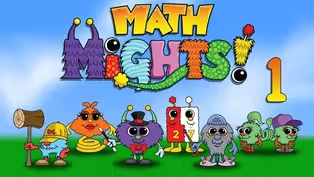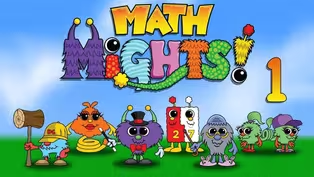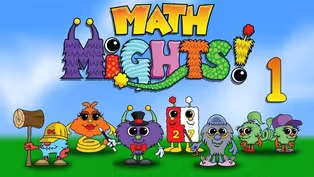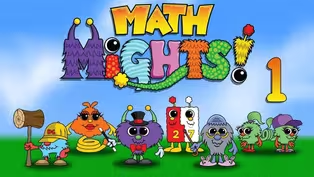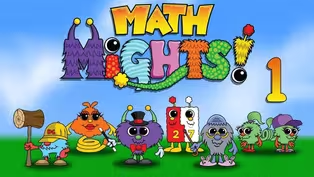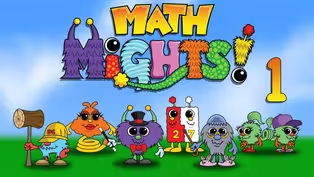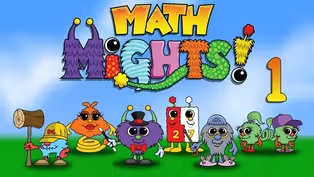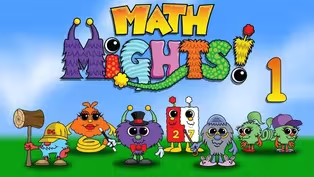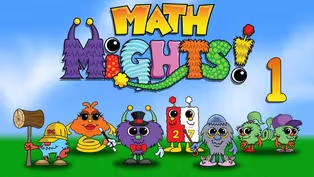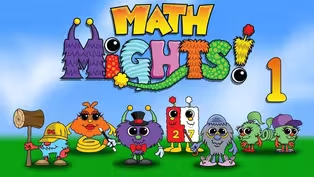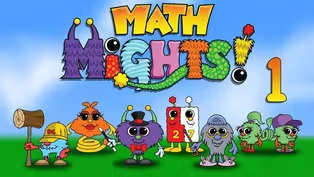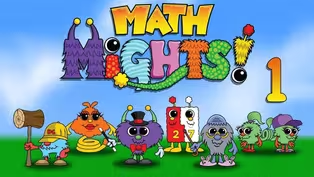Math Mights
Add Two-Digit Numbers
Season 3 Episode 309 | 16m 5sVideo has Closed Captions
Join Mrs. Markavich for a missing addend word problem with Professor Barble!
Join Mrs. Markavich for a missing addend word problem with Professor Barble! Next look out for two of favorite Math Might friends D.C. and Value Pak as they help use learn to add two-digit number in more than one way!
Problems playing video? | Closed Captioning Feedback
Problems playing video? | Closed Captioning Feedback
Math Mights is a local public television program presented by Detroit PBS
Math Mights
Add Two-Digit Numbers
Season 3 Episode 309 | 16m 5sVideo has Closed Captions
Join Mrs. Markavich for a missing addend word problem with Professor Barble! Next look out for two of favorite Math Might friends D.C. and Value Pak as they help use learn to add two-digit number in more than one way!
Problems playing video? | Closed Captioning Feedback
How to Watch Math Mights
Math Mights is available to stream on pbs.org and the free PBS App, available on iPhone, Apple TV, Android TV, Android smartphones, Amazon Fire TV, Amazon Fire Tablet, Roku, Samsung Smart TV, and Vizio.
Providing Support for PBS.org
Learn Moreabout PBS online sponsorshipMore from This Collection
Adding Tens-Tens and Ones-Ones
Video has Closed Captions
Join Mrs. Markavich for a missing addend word problem with Professor Barble! (15m 35s)
Write Equations to Match the Strategy
Video has Closed Captions
Join Mrs. Markavich for a missing addend word problem with Professor Barble. (16m 2s)
Video has Closed Captions
Join Mrs. Markavich for a subtraction word problem with Professor Barble. (15m 59s)
Video has Closed Captions
Join Mrs. Markavich for a missing addend word problem. (16m 6s)
Add 2-Digit Numbers & Write Equations
Video has Closed Captions
Join Mrs. Markavich for a word problem with her friend Professor Barble! (15m 59s)
Comparing Numbers Different Ways
Video has Closed Captions
Value Pak shows you the different ways to compare 2-digit numbers. (15m 44s)
Video has Closed Captions
Join Mrs. Markavich for a word problem with her friend Professor Barble! (15m 59s)
Video has Closed Captions
Join Mrs. Markavich for a word problem with her friend Professor Barble! (15m 59s)
Decompose/Compose #'s Different Ways
Video has Closed Captions
We show you different ways to decompose and compose 2-digit numbers! (15m 59s)
Video has Closed Captions
Join Mrs. Markavich & Dotson to talk about numbers with the Counting Buddy Senior! (16m)
Video has Closed Captions
Join Mrs. Markavich & Dotson for a Numeracy Talk with the Counting Buddy Senior (16m)
Video has Closed Captions
Join Mrs. Markavich for Numeracy Talk with Dotson working on conservation to 20. (16m)
Providing Support for PBS.org
Learn Moreabout PBS online sponsorship(happy music) (springing) (creaking) (squeaking) - [Kids] Math Mights!
- Welcome first grade Math Mights.
I'm Mrs. Markavich, and I'm so excited that you're here with me today.
Let's take a look at our plan for today.
First, we'll be solving a word problem with my friend Professor Barble.
And then we'll add two-digit numbers.
Let's warm up our math brain with my friend Professor Barble, who loves to conquer word problems.
Hey, Professor Barble!
(triumphant music) Professor Barble is a Math Might that lives in Mathville, and he loves to solve word problems.
And if he slows down to think what the problem is really asking, and he presses on his thinking cap, out come some really cool tools that help him create a picture of what the problem is asking.
You might ask yourself, what is a visual model?
A visual model is sometimes known as a model drawing, unit bar, tape diagram, or bar model.
Drawing a visual model helps to visualize the strategies and understand what the word problem is asking.
It's also a reading comprehension strategy for word problems.
Let's take a look at my template.
This is something that we use in first grade.
Let's check out our problem.
It says, "Some frogs were in the pond.
"Three jumped out, and now there are five frogs in the pond.
"How many frogs were in the pond at first?"
Well, my friend Jose says, "I think maybe we should add to solve the problem."
But Luke says, "Or wait, do we subtract?"
Professor Barble says, "Hold on a minute.
"Let's slow down and see what the problem is really asking."
He doesn't want us to guess, do I need to add or subtract?
He wants us to use a step-by-step visual model process to help create a picture of what the problem is asking us.
Our first step is to put the problem into chunks.
Let's do that together.
"Some frogs were in the pond," chunk.
"Three jumped out," chunk.
"And now there are five frogs in the pond," chunk.
Last part, "How many frogs "were in the pond at first?"
Chunk.
Step number two is we rewrite the question in sentence form with a blank space for the answer.
We do this so we know what we're solving for.
In first grade, we help you with this, but as you get better, you'll start to do this on your own.
Let's take a look at it.
It says, there were hm hm in the pond at first.
Step number three, we need to determine the who or what is involved in the problem.
Let's look at mine.
You can see right here it says, "Who or what?"
Well we know that there were frogs in the pond.
So I'm going to add the word "Frogs," as my who or what.
The next step would be to draw the unit bar.
You can see that I've done that for you.
I haven't put in the sections for you, but we'll do that together today.
And step number five is when we check when we add each chunk to our unit bar.
Let's do that part now.
It says, "Some frogs were in the pond," and I know that my who or what is the frogs, so I'm going to go ahead and check that part out.
Then it says, "Three jumped out."
I'm going to divide my unit bar like this, and I'm going to add the three right here.
I'm going to label it with the word "out."
It's really important to label our work when we're doing math.
And then I'm going to go back up and check it off that I put it in.
The next part says, "And now there are five frogs in the pond."
I need to add my five right here.
I need to label it with "in."
And then I need to go back up and check it off.
Check.
Then the last part says, "How many frogs were in the pond at first?"
I'm gonna go down here, and I think they're not telling me that part, so this has to be my question mark right here.
I'm going to put in the question mark, go back up and check it off like this.
Now that we've solved the problem, it's time for us to correctly compute and solve the problem together.
We use the word compute to tell us when to figure out the answer.
And my friend says, "Now I see what we need to do "to solve this problem."
Do you see it?
I think I need to add three and five to give me the whole number of how many frogs were in the pond at first.
I'll solve it down here for you.
Three plus five equals eight.
Our last step is to go back up and put in our answer in the sentence that we wrote in step two.
So we're going to say, "There were eight."
And remember what were in the pond?
"There were eight frogs in the pond at first."
Boys and girls, Professor Barble would be so proud of our word problem solving skills today, using the visual model process.
Let's head over and check out our I can statement of the day.
Today, our I can statement says, "I can add two digit numbers within 100."
Let's take a look at this problem, 17 plus 36.
I wonder if there's more than one way that we can solve this.
You know that you can show your thinking using drawing, numbers, or words.
Well, my friend Luke says, "I solved using Value Pack.
"I added the 30 and the 10.
"And then I added the six and the seven.
"Last I added the 40 and the 13."
Whoa.
You know what that means friends, we're going to need to call on my friend Value Pack.
Hey, Value Pack, we need help.
(happy music) Value Pack is a Math Might that lives in Mathville.
And Value Pack comes from a family that wears their value on their belly.
They can work together as a whole family when they click together, or they can work on their own because they each have their own value and they click apart.
Let's have Value Pack help us with this equation.
17 plus 36 equals hmm.
So I know that I want to decompose the 17 and the 36 like this.
I have the number 17.
And Value Pack is going to unclick and not hide that zero to show the 10 and the seven.
I'm going to grab the number 36.
And again, Value Pack is gonna help us and unclick and not hide the zero to show 30 and six.
And we can see that Luke said, "I added the 10 and the 30."
And when you add 10 and 30, you get the number 40.
And then he said, "He added the seven and the six."
And seven add six is the number 13.
And I know that 40 add 13 equals the number 53.
Wow.
That was some great thinking, Luke.
Now let's see if we can solve this another way.
My friend Jose said, "I solved using D.C. "I decomposed 17 into four and 13.
"I added four to 36 to get 40, "and then added on the 13 to get 53."
Whoa, I need to call on my friend, D.C. (happy music) Hey D.C., thanks for coming to help out.
Boys and girls remember, my friend D.C. is a perfectionist, and he likes things a certain way.
He wears a hard hat and carries a mallet with him.
And he likes numbers that are friendly numbers, or numbers that make a 10.
If those numbers are not friendly numbers, he uses his mallet to smash those numbers, or decompose them, into the numbers he wants in order to make a friendly number.
I heard Jose say he took the 17 and decomposed it into 13 plus four.
Let's have DC help us with that.
(cymbals clanging) Thanks, D.C. You can see we have 17, and we decomposed it into 13 and four.
Let's look at it on my board, and I'll help you solve that.
On the board, I have 10 frames.
I have the number 17, and then I have 36 shown in yellow.
I heard Jose say he took the 17 and decomposed it into 13 and four.
I'm gonna show you that right here, 13 and four.
I'm going to take this and go over here, because remember D.C. likes things a certain way, he's a perfectionist, and he wants to make a friendly number.
We're going to take four from here.
One, two, three, four, and now I have 13, and I put the four over here because I can make a 40.
I'm gonna take the 36 and the four to make the 40.
And then I can add the 13, just like it shows over here, to give me 53.
Wow!
Boys and girls you have solved this problem in two different ways.
Do you think that we can solve it a third way?
I think we should give it a try.
We still have the same equation, 17 plus 36.
But this time we're going to solve it counting on using tens and ones.
Let's take a look at mine.
I have it laid out for us, 17 plus 36 equals hmm.
I have 17, tens and ones on this side, and I have 36 tens and ones on this side.
I'm going to start with a greater number, 36, and I am going to count on.
I'm gonna go over and grab a 10.
And then we would say 46.
I'm gonna change this to show our number, 46.
Then, I think I only need one, two, three, four more ones so then I can make a 10.
Let's do that, first.
I'm gonna grab four ones, one, two, three, four, and now you can see if I push them all together like this, look, I have another 10.
10, 20, 30, 40, 50.
That's going to look like this.
And then the last thing that I have to do is just add my ones.
I'm gonna grab my three ones.
And I have solved this equation, 10, 20, 30, 40, 50, 51, 52, 53.
And here's my answer, 53.
We were able to solve that problem three different ways.
Let's take a look at how they were similar and different.
I have it all laid out for us on the overhead.
Let's take a look at it.
17 plus 36 equals hmm.
You can see that they were all similar because every single answer was the same, 53, 53, and 53.
But how I got to that 53 is a little bit different.
First, I use tens and ones to count on to come up with the answer 53.
Next, I used my friend D.C. to decompose the 17 to get the friendly number of 40, and then add 40 plus 13 equals 53.
I was also able to use my friend Value Pack and I decomposed by tens and ones to get 40 and 13.
And I know that 40 plus 13 equals 53.
Boys and girls, you really worked hard today.
We did a lot with decomposing numbers and using our friends D.C. and Value Pack.
Great job.
Now it's time for us to play a game called Grab and Add.
Each partner grabs a handful of base 10 blocks, which are tens and ones.
First, determine how many cubes you have then determine how many cubes you and your partner have altogether.
Let's try it.
Luke grabbed some base 10 blocks, And then Jose grabbed some base 10 blocks.
Luke says, "I have 45 cubes, and my partner has 37 cubes."
Let's take a look at what that looks like.
Luke has 45 cubes and Jose has 37.
I think we're going to use my friend Value Pack to help us solve this problem.
First, we're going to look at our tens.
I have 10, 20, 30, 40.
Then I have 10, 20, 30.
If I add my tens first, I have 10, 20, 30, 40, 50, 60, 70.
And that's right there with a 70.
Then I need to add my ones.
And I have five ones over here.
Six, seven, eight, nine, 10, 11, 12.
I'm gonna bring that right there.
And if I bring my 70 down like this I can add 70 and plus 12.
And I know that 70 plus 12 equals 82.
You can try this game with a friend.
You could use materials that are similar to mine like crayons, popsicle sticks, or even toothpicks.
Now it's your turn to add two-digit numbers.
You can do this using all of the strategies we practiced today.
Boys and girls, we had so much fun today, and we accomplished so much.
We solved a word problem with my friend Professor Barble, using the step-by-step visual model process.
And we used D.C. and Value Pack to help us add two-digit numbers.
And they had great strategies.
Until next time, kiss your brains.
(smooches) (happy music) (upbeat music) - [Kid] SIS4teachers.org.
- [Kid] Changing the way you think about math.
- [Woman] This program is made possible with funding from the Michigan Department of Education, Governor's Education Emergency Funds, the State of Michigan, and by viewers like you.
(upbeat music)


- Home and How To

Hit the road in a classic car for a tour through Great Britain with two antiques experts.










Careers that Work

Support for PBS provided by:
Math Mights is a local public television program presented by Detroit PBS
